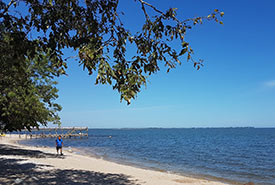Five ways to save a lake

Lake Winnipeg (Photo by Christine Chilton/NCC staff)
There has been a lot of bad news lately about Lake Winnipeg. Algae blooms occur regularly, and zebra mussels are settling into their new home. Lake Winnipeg was named the world’s most threatened lake in 2013 by Global Nature Fund, and some scientists have even declared that Lake Winnipeg is a lost cause.
Despite the current state of Lake Winnipeg and Manitoba’s other large lakes, there is both reason and evidence for hope. The current issues we are facing have occurred in other regions of Canada, including Ontario’s Great Lakes, and Manitoba’s large lakes have avoided problems, such as industrial pollution, that have degraded other large lakes. There are immense benefits that these lakes continue to provide to people, and they remain places of spectacular nature. Most importantly, there is still an opportunity to protect and restore the health of Lake Winnipeg.
1. Stop the establishment of new invasive species
Yes, zebra mussels are in Lake Winnipeg. And so are other aquatic invasive species, including common carp, rainbow smelt, white bass and Asian tapeworm. But these are still a small fraction of the species in the lake, which remains dominated by native species.
Management actions are limited once invasive species become established. The ideal scenario is to prevent these species from entering the lake and the watershed, and monitor our lands and waters so they can be detected early and eradicated. This is the opportunity we still have in Lake Winnipeg, in particular with quagga mussels and European common reed (phragmites).
2. Keep native fish populations healthy, particularly bottom feeders
Invasive species often spread rapidly because there are no natural predators to control them. In the Great Lakes, many native fishes, particularly bottom feeders, eat zebra mussels. Many of these same fish species are also found in Lake Winnipeg, such as lake sturgeon, freshwater drum and lake whitefish. The recent shift in the lake whitefish range to the southern basin of Lake Winnipeg may even be a response to the rapidly growing number of zebra mussels. Keeping populations of these fishes healthy may be our best defence in keeping zebra mussel populations in check.
3. Protect and restore shorelines
Lake Winnipeg and Manitoba’s other large lakes still have vast stretches of natural shorelines, such as coastal wetlands and sand beaches. These shorelines include areas designated as Important Bird Areas, such as Netley-Libau Marsh. In addition to providing important habitat for birds, and spawning and nursery habitat for fishes, shoreline vegetation plays a critical role in filtering lake waters. Lake Winnipeg still has many important coastal habitats. Protecting and restoring them is critical to the health of the lake. In urban and rural areas, including parks and waterfront communities, there are many opportunities to restore shorelines with native vegetation while maintaining access to the waterfront.
4. Find innovative ways to keep water on the land
This is a tough one. For over 100 years, we have been trying to get water off the land as quickly as possible. In some watersheds that are dominated by urban areas and farms, this can mean that the sponge that nature’s wetlands, grasslands and forests once provided to store and filter water has been replaced with hardened surfaces and drains. When water flows quickly from land to lake, it often carries nutrients. These nutrients, and in particular phosphorus, provide fertilizer for algae.
There are many examples of how this can be solved. Septic systems can be inspected and maintained to ensure that no nutrients are seeping into the lake. Protecting natural habitats that help hold water on the land, such as the Nature Conservancy of Canada’s work in the Interlake Region, is also part of the solution.
5. Celebrate what we have
Despite zebra mussels and algae, Lake Winnipeg remains an extraordinary place. From one of the world’s most productive freshwater fisheries, to white pelicans, to some of Canada’s largest freshwater wetlands, Lake Winnipeg is a unique and special ecosystem. We need to celebrate this lake and focus on the solutions, not the problems. As stewards of one of the planet’s greatest freshwater resources, we have the opportunity to demonstrate success to the rest of the world. These waters are a foundation of Manitoba and support our economy, lifestyle and identity. It is not a lost cause because options remain to protect and restore Lake Winnipeg.
This article originally appeared in The Cottager magazine and is reposted with permission.



